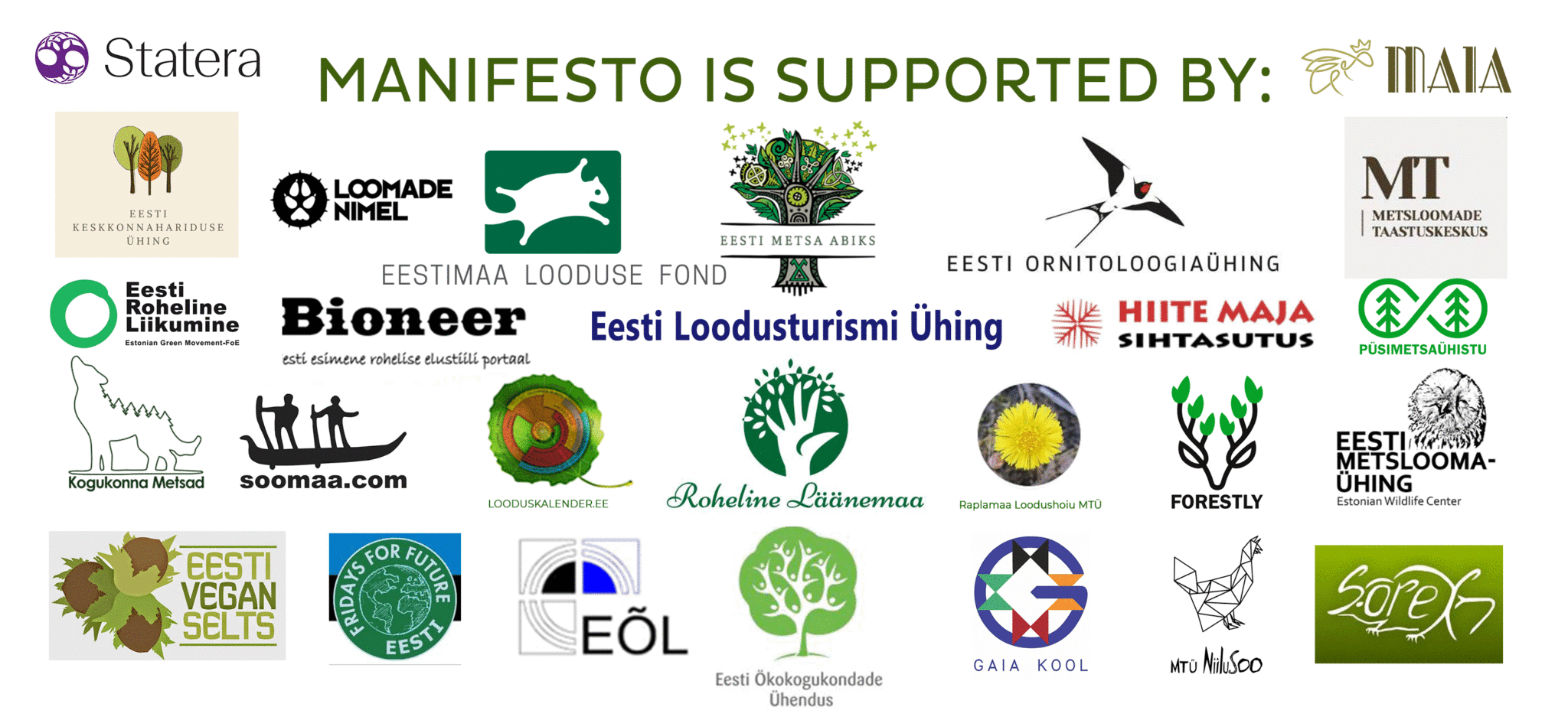ESTONIAN FOREST MANIFESTO
Forests carry four main kinds of values for mankind: ecological, economic, social and cultural. These four values must be balanced.
As a developed country, the Republic of Estonia should be a state where this balance must be ensured by laws, regulations, and their appropriate application. In the opinion of the authors of this manifesto, the imbalance in Estonian forestry, a.k.a. the set of reasons for the Third Forest War, is rooted in these four values, which are only balanced on paper. In reality, forestry is dominated by the part of the sector that supports intensive forest management, promoting it with heavy lobbying and public relations activities, and publicly comparing the act of felling trees to harvesting arable land.
In order to restore balance, we hereby present our position and demands.
1. A FOREST IS A HOME, NOT A FIELD
With this manifesto and demonstration on 21 March, we want to make heard the voice of those people, who want to preserve the community forests near their homes, protect primary forests, valuable habitats and green corridors, maintain biodiversity and ancient sacred sites, benefit from the healing properties of the forest environment, forage for berries, mushrooms and healing herbs, walk along hiking trails and enjoy the silence of the forest.
Cultural, social and ecological values cannot be measured in money. Forests are an inseparable part of our identity.
2. STRICTER LIMITS ON CLEARCUTTING AND FORESTRY EQUIPMENT
As a consequence of decisions made within the Estonian forestry policy, clearcutting and heavy forestry machinery have become the main methods used in forest management. The result is damaged soil and undergrowth, destroyed populations of insects and small mammals. Animals and birds are left without a habitat for decades. The water regime is disturbed.
Increasingly warm winters and soil that doesn’t freeze are factors that amplify these problems.
The lease payments for forestry equipment should not be a decisive factor for national forestry policy. The policymakers must understand that we cannot persist in changing conditions with practices that destroy biodiversity. We must once again adopt more sustainable management practices, ones traditionally used in the past, and support the search for new innovative solutions at the governmental level.
3. DECREASE LOGGING VOLUMES TO A SUSTAINABLE LEVEL
The diversity, biodiversity and cultural value of Estonian forests is in danger, since volumes are dominant factors in forestry, instead of added value. Instead of producing more high value and innovative products made of wood here, cutting at the right time, selectively and in smaller volumes, to get timber of a higher quality and value, cutting is done year around, especially in state-owned forests, regardless of market prices. A significant part of our valuable forests end up as fuel for heating abroad.
According to the Stockholm Environmental Institute (SEI) report, cutting volumes in Estonia should not exceed 8 million cubic metres per year. Since we have been cutting above that limit for years, at the expense of our children and grandchildren, to compensate that loss to them as well as to our natural environment, the cutting limits must be reduced to below 8 million cubic metres per year.
If these volumes are not reduced, our policymakers should at least have the courage to admit it – at this rate, the surface area of mature forests in Estonia will decrease to an alarming extent.
Already today, large-scale cutting is being carried out in protected areas and limited management zones.
As a renewable natural source, the critical stocks of forest should be determined in accordance with the Sustainable Development Act, and protected areas must be put under actual protection, which would disallow the use of destructive practices not prohibited by law in private as well as state-owned forests.
4. PROHIBITION PERIODS FOR ALL FORESTS
At the moment, the cutting prohibition period lasts from 15 April until 15 June only partially in state-owned forests. Intensive clear cutting is not permitted during this period, but emergency forestry and cutting activity is still allowed.
Three months of cutting prohibition in all Estonian forests in the spring/summer period is the minimum that we should instate in order to allow wildlife to start a new cycle of life. This is a question of conscience and culture, but it can also be reflected statistically. Our wild bird populations have decreased by a quarter over the last few decades. At the same time, the year 2019 was a record year for our tourism sector – the export of services rose to 2 billion euros, of which 700 million comprised of nature tourism. If the large-scale clearcutting continues, especially in the spring/summer period of bird nesting and reproduction, the Estonian tourism sector will suffer further and deeper losses in both revenue and reputation.
5. THE FUTURE OF ESTONIAN FORESTRY MANAGEMENT
Taking into account the global efforts to protect the climate and biodiversity, including the European Union’s Green Deal and the domestic targets in this manifesto, the current Estonian system of forest management must be changed – from the narrow circle of decisionmakers to a much broader base. Those responsible for forest management must adjust to these unavoidable changes, abandon outdated dogmas, renew their approach and cooperate with all stakeholders in an open and inclusive manner.
At a time, when the sixth mass extinction of species has accelerated in pace, a renewed State Forest Management Centre (RMK) must become an institution that departs from the principle of forest protection – RMK 2.0 should be a State Forest Protection Centre.

